Alienware M11x: World’s Smallest Gaming Laptop
by Jarred Walton on March 30, 2010 8:16 AM ESTAcceptable Application Performance
For general applications, the GPU is less important and so the M11x is going to end up quite a bit slower than many other "midrange" laptops. We should see about the same level of performance as the ASUS UL50Vf, with slightly better scores from the 7200RPM hard drive. That's the theory at least. As noted earlier, the actual overclock appears to be 1.60GHz instead of 1.73GHz, which means the UL50Vf is clocked 8.3% higher and should outperform the M11x except in cases where the faster HDD and/or GPU come into play. We've colored the N61Jv black and the UL50Vf gold for ease of comparison in our application benchmarks.
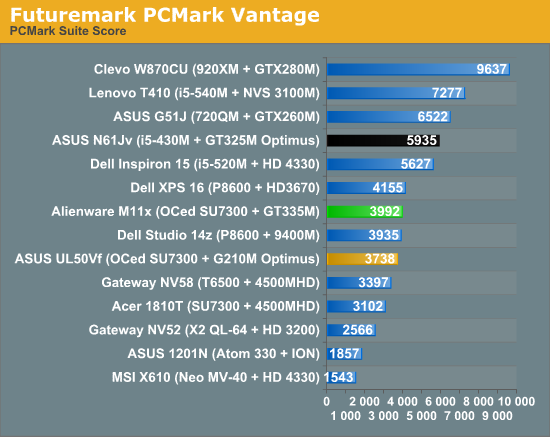

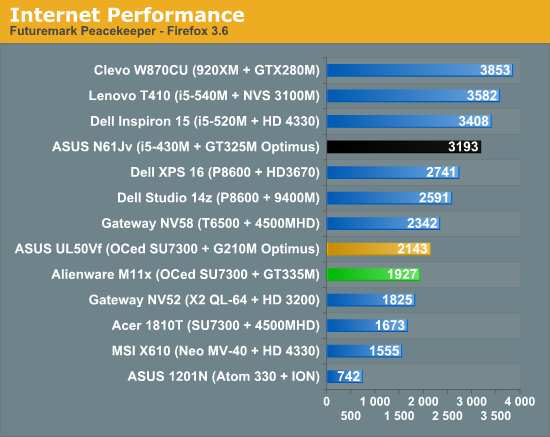
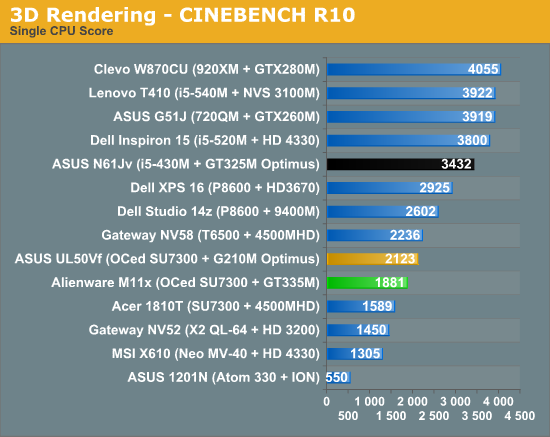

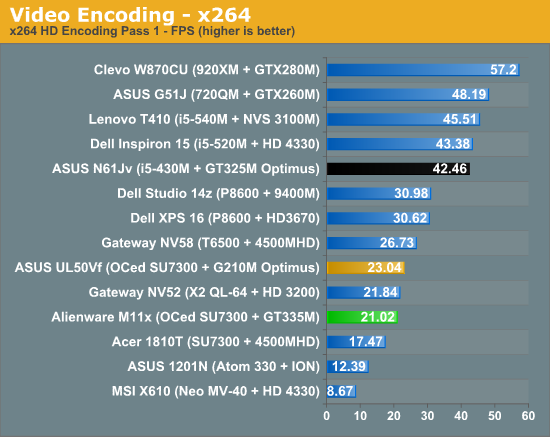
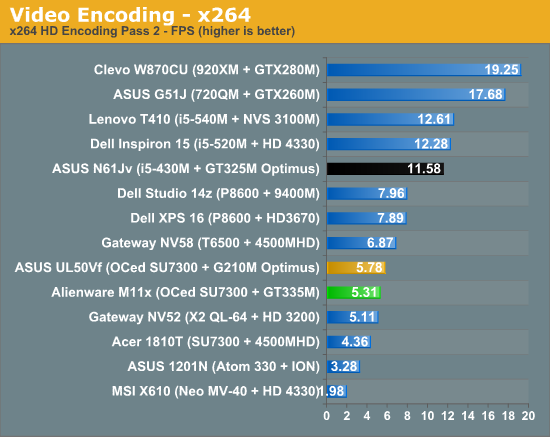
As expected, the M11x ends up beating the UL50Vf in some tests and trailing in others. It's 25% faster in PCMark05 (mostly from the GPU result, it appears), 7% faster in PCMark Vantage (GPU and HDD), but around 10% slower in the CPU-limited tests of Peacekeeper, Cinebench, and x264 encoding. Again, it's odd that Alienware would limit the multiplier to 6x when overclocked but then claim to have a 1.73GHz CPU. Note also that in overclocked mode, the various power saving CPU functions don't seem to kick in—CPU-Z reports the processor running at a constant 1.60GHz instead of dropping to a 4x multiplier when idle.
Does any of this really matter? In terms of getting acceptable application performance, not really: practically any dual-core CPU will be fast enough for general computing, and if you're doing 3D rendering or video encoding you should be using a different tool. (NVIDIA would of course recommend Badaboom with CUDA for video encoding, and we admit that it's quite speedy on the GT335M.) If on the other hand you believe in truth in advertising, Alienware needs to update the BIOS or update their web page. We'd also like to see SpeedStep functioning with the overclocked CPU, as we've seen that work on the ASUS laptops.

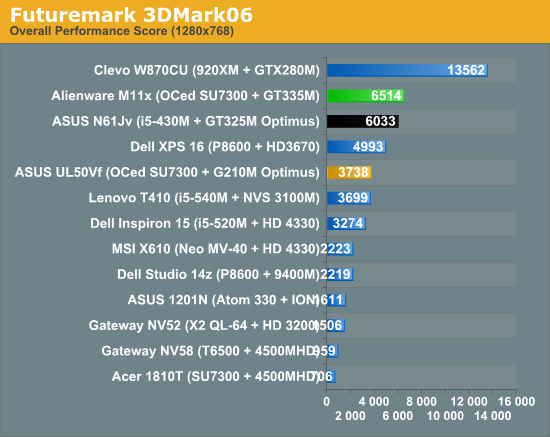
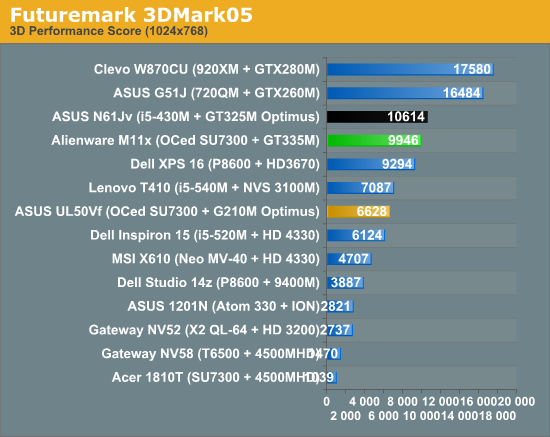
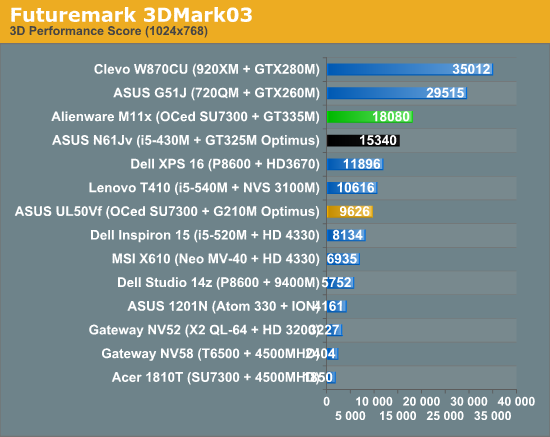
Our final stop will be the 3DMark results. Yes, they're synthetic and we've already looked at gaming performance. For those that like to see the numbers, though, we've included them as usual. The M11x makes short work of the ASUS UL series, with scores that are anywhere from 50% to 220% higher. 3DMark Vantage shows very close to linear scaling with the shader processing power of the GT335M compared to the G210M. (The M11x also manages to run Vantage at Performance defaults (but 1280x768 resolution) with a reasonable score of P3217, if you're wondering.) The N61Jv matchup is a bit more sensible, with the M11x leading by 7% in 06, 18% in 03, and 32% in Vantage… but oddly it trails by 7% in 3DMark05. Now you know why we take 3DMark results with a large dose of skepticism; the 3DMark results are only truly indicative of 3DMark performance.










47 Comments
View All Comments
Ryan Smith - Wednesday, March 31, 2010 - link
Congrats Jarred.May I suggest the name Ryan for your child? It works equally well as both as a girl's name and a boy's name.;-)
KaarlisK - Tuesday, March 30, 2010 - link
When Intel mobile CPUs are overclocked by doing BSEL mods (basically, shorting some pins to tell the chipset that the CPU requires a higher FSB clock), the CPUs fall back and are locked to their lowest multiplier - 6x. Maybe ASUS bypassed this protection and Alienware did not...cknobman - Tuesday, March 30, 2010 - link
to include the Sony CW (VPCCW26FX) laptop in your reviews, it would have been a much better choice than the Asus for comparison sake. The sony is a 14' chassis with a core i5-520 and a 330m nvidia and only costs $899. Much closer in size and price to the Alienware.Why is there no one giving the Sony any attention at all? Its not just anand its everyone that seems to be totally disregarding this laptop.
NICOXIS - Tuesday, March 30, 2010 - link
I'll second that, its like the only 14" laptop with a decent GPU, less than 2.5KG, Arrandale CPU, DDR3, good battery life and under 1000.I haven't seen any decent Vaio CW review out there.
xFlankerx - Tuesday, March 30, 2010 - link
The Alienware may be the cheapest, smallest laptop, but there is one more expensive competitor:The Sony Vaio Z is a 13.3" laptop that outperforms the Alienware in almost every single area, including aesthetics. The only downside is that the Vaio Z costs upwards of $2000.
erple2 - Tuesday, March 30, 2010 - link
The Sony Z series has the 330m processor, which has 24 fewer Unified shaders (48 vs. 72). The graphical capabilities of the 335m could be up to about 50% faster in the best case scenario.To be fair, that's still more than in the tested ASUS notebook...
But the Z series starts at 1900 dollars, which is about 1000 more than the M11x...
The CW series has the 310m processor, which has a total of 16 unified shaders. That's 1/6th the total number of the M11x. Sure it starts at about the same price.
However, that would answer the side question of whether the GPU in the Sony is significantly slower than the one in the M11x - I'm betting the answer is "yes". I don't think that there's any comparison, honestly. Though, perhaps that's the whole point of the article - how much does the GPU matter, and how much does the CPU matter? For gaming, I think that this article showed quite clearly that the GPU was "king".
cknobman - Wednesday, March 31, 2010 - link
Not sure what CW your looking at but there are CW models with a 330m in them - I own one.NICOXIS - Wednesday, March 31, 2010 - link
The point is that the Vaio CW is a LOT more comparable to the M11x than the Asus that was chosen in the article. It is similar in size 13" vs 14" (size not display), M11x has slightly better GPU but CW has arrandale and price wise they are in the same level.JarredWalton - Wednesday, March 31, 2010 - link
You'll notice that I specifically mentioned this in the conclusion:"The only competing laptops in terms of performance are going to need something like the GT330M, GT240M, GeForce 9700M GTS, or a faster GPU. Finding laptops with those GPUs for a reasonable price is fairly easy—the ASUS N61Jv is one example, and the Sony VAIO VPCCW22FX/R is another—but the VAIO is the smallest reasonable competitor we can find and it still has a 14" chassis and significantly less battery life."
The VAIO is advertised as 4 hours of battery life, and it sounds about right. The ASUS N61Jv is similar and with Optimus (i.e. IGP) it still gets about 4 hours idle. Yes, the Sony will definitely be faster in the CPU department, and GPU performance will be close. It has only 48 SPs but as pointed out the clocks are quite a bit higher than the 335M--net difference is that the 335 has 28% more shader potential; I don't know if they have the same number of ROPs or not, but the 330 has a 575 core clock vs. 450, so that's another are of comparison. RAM bandwidth is the same. If you're more interested in performance than battery life, I'd recommend an i3-330M over the overclocked CULV laptops without hesitation.
EDev - Tuesday, March 30, 2010 - link
I currently possess the M11x. I pick the unit for the lite keyboard as well as the form factor.Battery life is great, better than my other Gateway lt3103 (gave to Girlfriend). Speed is great, video speed is what I love on the unit.
I do agree about the keyboard being an oddity, actually I find it slippery. If you have any form of skin oil, food oil, etc., my fingers slip easier than on the Gateway.
Also, I dislike the plastic cover/protector on the screen, not only for the glare, but also like other platforms it touches the keyboard and puts lines on the screen which needs to be wiped off.
Other than that, it is a netbook on steroids with battery life and power.